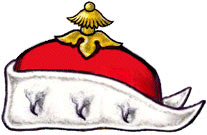A Scottish feudal barony
is land that has by charter been erected by the Crown in liberam baronium, giving
the owner, whether by inheritance or by purchase, a whole bundle of land, mineral, and
other rights, including certain rights of public justice, privileges not belonging to
ordinary estates.
The holders of these
baronies are styled Barons or Baronesses. Scottish Barons are like continental Europe
barons in nobiliary status. The recent Scottish Land Reform Act, abolished the feudal
system in Scotland, but has preserved the dignity of the barons of Scotland.
A Scottish baron has
various armorial prerogatives not unlike those of a peer, including a cap of maintenance,
supporters, a barred helm garnished with gold, a robe or mantle, uniquely specified flags
and, as befits the ancient institution, a Baron Court. A baron of Scotland is also
permitted two pipers, each displaying an armorial pipe banner.
The tinctures and
furring of the chapeau or cap of maintenance form several categories:
1. Gules
furred Ermine: a Baron of the Kingdom of Scotland, in possession of the barony;
2. Azure
furred Ermine: the heir to such a Baron, no longer in possession (called "the
Representer of the Baronial House of X");
3. Gules furred Ermines: a Baron of Argyll and the Isles, or of one the
older Earldoms,
still in possession;
4. Azure furred Ermines:
the heir to such a Baron, no longer in possession.
The cap is depicted
ensigning the shield of arms, beneath the helm and crest. The robe, or mantle, may be
displayed draped (very much in the European fashion) behind the achievement actually in
possession of a barony, and is described as a feudo-baronial Mantle, Gules doubled of silk
Argent, fur edged of miniver and collar Ermine, and fastened on the right shoulder by five
spherical buttons Or.
The Scottish baronial
helm is of steel with one or three grilles (one being by far the more usual) garnished
with gold. The helm is normally shown facing dexter but may be shown affronty. Supporters
may be used by the heirs of baronies held before 1587, and possibly for baronies held
between that date and 1627 (the point is not fully resolved).
On the matter of flags,
a Scottish baron may adorn the top of his flagstaff with a cap of maintenance, and employ,
as he sees fit, standards, guidons and pennons.
The most recent form of
style and title for Barons is, e.g.,"Camilo Agasim-Pereira of Fulwood, Baron of
Fulwood and Dirleton", and for Baronesses, e.g., " Maxine Ann Agasim-Pereira of
Fulwood, Lady Fulwood & Dirleton, or The Baroness of Fulwood & Dirleton ".
The full style may include the prefix "The Much Honoured". Older styles, which
included for example "Mistress Maxine Ann Agasim-Pereira of Fulwood, Lady of the
Barony of Fulwood" and "Madame Maxine Ann Agasim-Pereira of Fulwood &
Dirleton", may presumably continue in use for those who have been thus recorded.
The Lyon Court has
officially revived the ancient address, in speech, of, e.g., "Lady Fulwood". The
wife of a Baron may use a similar style. Some barons use the title "of that
Ilk". The word Ilk comes from the Anglo-Saxon and means same. Thus "Fulwood of
Fulwood" is "Fulwood of the Same" or correctly "Fulwood of that
Ilk". The origin of this usage is lowland, and the highland chiefs used to call
themselves only by their clan name, i.e. MacLeod, MacGregor, etc., but did not find this
sufficient in the capital. Therefore, and not to confuse themselves with the Lowland
Lairds, they began to use their name twice and this is why we have The MacLeod of MacLeod,
The MacGregor of MacGregor, etc.
The holder of a barony
which was formerly held directly from the King has
always been entitled to use the style
"The Laird of Fulwood". This style
should not be used by holders of baronies
formerly held from a great lord,
but in practice it is nowadays extended to all holders of
baronies.
In Scotland the holder
of a barony has, implicitly, a Baron Court. The president of such a court is a
Baron-Baillie and the chief officer a Baron-Sergeant (or Baron-Officer).
The insignia of a
Baron-Baillie is a flat cap of justice, environed by two
guards of braid and usually in
the livery colours of the baron concerned.
A very few Baron-Baillies have gowns, badges
and pendants relevant to the
estate they serve. The symbols of office of the
Baron-Sergeant (or Baron-
Officer) are a white Ell-wand (or Wand of Peace), one Scots ell
in
length (approximately thirty-seven inches), together with a horn.
There is entity called
the Convention of The Baronage of Scotland, but
they do not represent the baronage it's
merely a private club, they do not
speak for the Barons of Scotland.
November 28th has been
appointed Scottish Baron's Day, it the date that
the Act of 2000, became effective.
In the year 2000 the
Scottish new parliament voted to abolish the
feudal
tenure and judicial power of the Barons of Scotland, but it was careful to
state in it’s section 63 the dignities and offices of the Barons:
63. Baronies and other
dignities and offices
Any
jurisdiction of, and any conveyancing privilege incidental to, barony
shall on the
appointed day cease to exist; but nothing in this Act affects
the dignity of baron or any
other dignity or office (whether or not of feudal
origin).
Therefore
preserving the ancient office and dignity of the Barons of Scotland.
![]()
